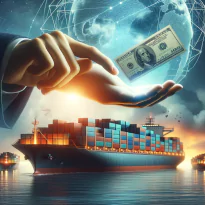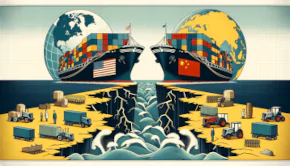Assessing the Impact on Trade with China
The placement of import tariffs on China marked a significant shift in U.S. trade policy with China. Resulting in a trade war between the world’s two largest economies. Designed to reduce the trade deficit and protect American industries; these import tariffs affected billions of dollars worth of Chinese goods.

When the Trump administration placed tariffs on goods bought from China it launched a lot of discussion on how they affected American jobs, including the economy. Moreover, different studies show different effects, like job losses and changes in how much things cost.
To make it easier to follow, there’s a glossary just below to explain some of the terms used in this discussion, like ‘tariffs’ and ‘GDP.’ This will help you understand the important points about the U.S. and China’s trade
Table of Contents
- Glossary of Terms
- What is a Tariff Information Label?
- What Was One Long Term Effect of High US Tariffs
- Impact to U.S. Jobs from China Tariff
- Economic Analysis by Think Tanks and Policy Groups
- Revenue and Broader Economic Impacts From Tariffs on China
- Who Benefited From The Tariffs on China?
- US-China Trade Who Paid the Price?
- US-China War
- China Tariff
- Biden China Tariffs
- Section 301 Exclusions
- US Trade Deficit with China
For those readers who are unfamiliar with Tariffs let’s define a few terms.
Glossary of Terms
Below are terms used to describe refer to tariffs.
- Tariffs: Taxes imposed by a government on imported goods and services. They are used to restrict trade, as they increase the cost of imported goods and services, making them less attractive to consumers.
- Trade War: A situation where countries restrict each other’s trade by imposing tariffs or quotas on imports. This can lead to a cycle of retaliatory measures.
- GDP (Gross Domestic Product): The total value of goods produced and services provided in a country during one year. It’s a broad measure of a nation’s overall economic activity.
- Import: To bring goods or services into a country from abroad for sale.
- Congressional Budget Office (CBO): A federal agency within the legislative branch of the United States government that provides budget and economic information to Congress.
- Real Income: The income of an individual or group after taking into consideration the effects of inflation on purchasing power.
- Supply Chain: The sequence of processes involved in the production and distribution of a commodity.
- Retaliatory Tariffs: Tariffs imposed by a country in response to similar tariffs imposed by another country.
- Free Enterprise: An economic system where private businesses operate in competition and are largely free of state control.
- Free Trade: International trade is left to its natural course without tariffs, quotas, or other restrictions.
- Purchasing Power: The financial ability to buy products and services.
- Economic Growth: An increase in the amount of goods and services produced per head of the population over some time.
- Think Tank: An organization that performs research and advocacy concerning topics such as social policy, political strategy, economics, and the military.
- The Heritage Foundation: A conservative American think tank based in Washington, D.C., focusing on public policy.
- Trade Policy: A government’s policy governing international trade. It involves tariffs, trade agreements, and monitoring imports and exports.
- Section 301 exclusions: are a critical aspect of the U.S. trade policy, particularly in the context of the trade relationship with China. These exclusions refer to specific products that are exempted from the additional tariffs
What is a Tariff Information Label?
A Tariff Information Label (TIL) is a standardized document designed to provide consumers with clear, concise, and comparable information about the costs and terms of electricity and gas tariffs offered by energy suppliers.
Similar in concept to nutrition labels on food products, TILs are aimed at empowering consumers to make informed decisions about their energy choices. They typically include key information such as the name of the tariff, the unit rate of energy, standing charges, contract length, exit fees, and any discounts that apply.
This information helps consumers understand what they will be paying, compare different tariffs easily, and switch suppliers if they find a better deal.
The introduction of TILs is part of broader efforts in many regions to increase transparency in energy markets, promote competition among suppliers, and ultimately provide consumers with better services and rates. In an age of increasing energy costs and environmental awareness, TILs play an important role in helping consumers manage their energy consumption and expenses effectively.
What Was One Long Term Effect of High US Tariffs
One long-term effect of high U.S. tariffs has been the alteration of global trade patterns. High tariffs, typically imposed to protect domestic industries from foreign competition, can lead to several significant consequences over time:
- Shift in Trade Partnerships: Countries facing high tariffs from the U.S. might seek alternative markets for their products, potentially reducing their economic reliance on the U.S. market. This can lead to the formation or strengthening of trade alliances with other countries.
- Domestic Industry Impact: While the immediate goal of tariffs is to protect domestic industries, in the long term, these industries may become less competitive globally. Without the pressure of foreign competition, there’s less incentive for innovation and efficiency, potentially leading to stagnation or decline in the global competitiveness of these industries.
- Consumer Prices and Choices: High tariffs can lead to increased costs for imported goods, which are often passed on to consumers. This can result in higher prices and reduced choices for consumers in the domestic market.
- Retaliatory Measures: Other countries may respond to U.S. tariffs with their tariffs on American goods. This can hurt U.S. exports, impacting industries and workers in sectors that rely on foreign markets.
- Global Supply Chain Reconfiguration: High tariffs can prompt companies to alter their global supply chains. This might involve shifting manufacturing or sourcing of materials to countries with lower tariff barriers, which can have long-term implications for global trade networks.
- Impact on International Relations: Sustained use of high tariffs can strain diplomatic relations with trading partners and might lead to broader economic conflicts or trade wars, affecting international relations and cooperation.
These effects are influenced by the specific sectors targeted by the tariffs, the countries involved, the duration and intensity of the tariffs, and the overall context of global economic conditions and policies.
Impact to U.S. Jobs from China Tariff
Studies on Job Loss and Gain:
- A study from the Carnegie Endowment highlighted that Trump’s trade policies resulted in a loss of nearly a quarter million U.S. jobs.
- Forbes: Reported significant harm to companies involved in trade with China due to the tariffs and the ensuing trade war.
- Reuters: Cited a business group study estimating a peak loss of 245,000 U.S. jobs, with a potentially positive effect if tariffs were scaled back gradually.
- The Conversation: Noted the mixed impact of Trump’s steel and aluminum import tariffs, benefiting up to 400,000 workers but potentially negatively impacting 4.6 million others.
- The Hill: Referenced a Federal Reserve study concluding that the tariffs caused job losses and higher prices.
- Another study mentioned by The Hill forecasted a reduction in U.S. economic growth and the loss of 134,000 jobs due to tariffs on Chinese imports.
Economic Analysis by Think Tanks and Policy Groups
The Heritage Foundation’s Viewpoint:
- The Heritage Foundation, supported by Congressional Budget Office data, outlined the negative impact of tariffs on the U.S. economy.
- Key issues included increased costs of goods, business uncertainty, and risks of retaliatory tariffs.
- Notably, the Heritage Foundation, a conservative think tank, criticized the tariffs as harmful.
Congressional Budget Office (CBO) Estimates:
- The CBO projected a reduction in U.S. GDP by 0.3% and a decrease in real income for the average household by 0.4% by 2020 due to the tariffs.
- The Heritage Foundation advocated for the elimination of these tariffs and a shift towards policies like lower taxes, fewer regulations, and free trade.
Revenue and Broader Economic Impacts From Tariffs on China
Financial Outcomes of Tariffs:
- The Trump administration’s tariffs on China were estimated to generate $73.9 billion in revenue.
- However, these tariffs also had broader economic impacts, such as potential reductions in economic growth and household income.
Who Benefited From The Tariffs on China?
Farmers were among the groups that benefited from President Trump’s tariffs on China, albeit indirectly. In hopes, of offsetting the losses from Chinese trade payback against American farmers. Trump authorized payments to U.S. farmers totaling $28 billion in 2018 and 2019. Additional aid was promised with $19 billion in April and $14 billion in September of an unspecified year, bringing the total bailout to $61 billion. These payouts to farmers represented over 92 percent of the tariff revenue proceeds from the trade war with China.
US-China Trade Who Paid the Price?
The import tariffs imposed by the Trump administration on Chinese goods did not directly affect China as a payer. Instead, they were paid by U.S.-registered companies to U.S. customs. When these goods entered the United States. These costs were often passed onto customers, and manufacturers through price increases. While President Trump stated that China was paying tariffs to the USA, the actual financial burden fell largely on American businesses and consumers.
US-China War
The import tariffs imposed by the Trump administration on products such as steel and washing machines appear to have benefitted certain workers in those industries. The tariffs on steel products helped create several thousand jobs in the steel industry. The import tariffs on washing machines are associated with approximately 1,800 new jobs at companies like Whirlpool, Samsung, and LG in the United States.
However, the benefits to these workers need to be weighed against the negative impacts on workers in industries that use imported materials. These materials became more expensive due to tariffs.
Which could reduce U.S. exports. Overall, economists have suggested that any job gains in sectors protected by tariffs were more than offset by losses in other sectors. Furthermore, the costs to consumers due to higher prices from tariffs were substantial. With estimates indicating a very high cost per job created in the protected industries.
Some American companies faced increased production costs due to tariffs. Increase prices or manage the burden through various strategies, such as accepting lower profit margins or cutting costs.
Which could include reducing wages and jobs. Additionally, Chinese suppliers did bear some of the cost indirectly. For example, by offering discounts to maintain market share. China also retaliated by imposing tariffs on U.S. goods, which affected Chinese importers similarly. Which is why Trump’s China Tariffs cost you more money is important.
Tariffs on goods imported from China can end up costing consumers more money due to several interconnected economic factors:
China Tariff
Increased Cost of Imported Goods:
Tariffs are essentially taxes on imported goods. When the U.S. imposes tariffs on Chinese imports, those goods become more expensive as importers and retailers often pass these additional costs onto consumers. This means higher prices for goods that were previously imported from China at a lower cost.
Wider Range of Affected Products:
China exports a vast array of products to the U.S., ranging from electronics and machinery to clothing and toys. Tariffs on these goods can affect a broad spectrum of consumer items, potentially leading to price increases in various sectors, not just in specialized or luxury goods.
Supply Chain Disruptions:
Many U.S. companies rely on components or raw materials imported from China for their production. Tariffs can increase the costs of these inputs, leading to higher production costs for American companies. These costs may then be transferred to consumers in the form of higher prices for finished products.
Retailers and Small Businesses Bearing the Brunt:
Small businesses and retailers, which have less capacity to absorb additional costs compared to larger corporations, might be particularly affected. They might have to increase prices more significantly to maintain their profit margins.
Reduced Consumer Spending Power:
As the prices of goods rise, consumers’ purchasing power decreases. This means that for the same amount of money, consumers can buy fewer goods than before, effectively reducing their standard of living.
Potential Retaliatory Tariffs:
In response to U.S. tariffs, China might impose its tariffs on American exports. This can affect U.S. industries that export to China, potentially leading to job losses or higher production costs in those industries, which again can trickle down to consumers.
Long-Term Economic Impact:
The uncertainty and increased costs associated with tariffs can lead to broader economic impacts such as reduced investment, disruptions in the global supply chain, and strained international trade relations. These factors can contribute to a less efficient global economy, potentially leading to higher costs and fewer choices for consumers in the long run.
Tariffs on China can lead to a cascading effect on the economy, influencing everything from the price of individual consumer goods to broader economic factors like supply chain dynamics and international trade relationships, ultimately costing consumers more money.
Biden China Tariffs
The Biden administration has handled tariffs on China by maintaining a cautious approach, with an emphasis on extending certain tariff exclusions while reviewing the overall tariff policy. Specifically, the U.S.
Trade Representative (USTR) extended exclusions on tariffs for a wide range of products from China. These exclusions, which cover both general products and COVID-related items, include various manufacturing components, consumer products like safety glass sheets, small electric motors, and clothing items.
The extension, which shifted the expiration dates from December 31, 2023, to May 31, 2024, was aimed at allowing U.S. importers more time to diversify their sourcing away from China, aligning with the administration’s agenda to reduce reliance on Chinese imports.
Moreover, the USTR has been conducting a mandatory four-year review of the Section 301 actions that were initiated under the Trump administration.
This review is essential to determine the effectiveness and economic impact of these tariffs and whether they should be kept in force. The Biden administration had considered removing some tariffs as a way to reduce inflationary pressures, but this consideration seems to have been paused due to geopolitical factors, including China’s military activities near Taiwan.
Overall, the Biden administration’s handling of China tariffs indicates a focus on cautious evaluation and strategic consideration of economic and geopolitical factors. The administration seems to be balancing the need to protect domestic industries and maintain pressure on China against the impact of tariffs on U.S. businesses and consumers, as well as broader international relations.
Section 301 Exclusions
Section 301 exclusions are a critical aspect of the U.S. trade policy, particularly in the context of the trade relationship with China. These exclusions refer to specific products that are exempted from the additional tariffs imposed under Section 301 of the Trade Act of 1974. This legislation allows the U.S. to impose trade sanctions on foreign countries that engage in unfair trade practices.
The exclusions process was introduced alongside the implementation of Section 301 tariffs on Chinese goods, primarily in 2018 and 2019.
It was designed to mitigate the impact of tariffs on U.S. businesses and consumers by allowing certain products to be imported from China without additional duties. Companies could apply for these exclusions based on criteria such as the availability of the product only from China and the potential for severe economic harm if the product were subject to tariffs.
Over time, these exclusions have been periodically reviewed and extended. Most recently, the U.S. Trade Representative (USTR) extended the exclusions for a wide range of products, including both general and COVID-related items.
This extension aims to give U.S. importers more time to diversify their supply chains away from China, aligning with the broader strategic objectives of the U.S. government. The extension also reflects ongoing considerations about the impact of tariffs on the U.S. economy and the global supply chain.
However, the management of these exclusions, including their extension and eventual expiry, has significant implications for businesses planning future shipments and overall trade strategies. The ongoing review and changes in the exclusion lists reflect the dynamic nature of the U.S.-China trade relations and the complexities involved in balancing various economic, political, and strategic interests
US Trade Deficit with China
In their December and Annual Report for 2023, the International Trade in Goods and Services shows us that in November 2023, the U.S. experienced a decrease in its monthly international trade deficit, going from $64.5 billion in October to $63.2 billion.
This reduction was a result of a more significant drop in imports compared to exports. Specifically, the deficit in goods traded was slightly lower at $89.4 billion, while there was an increase in the surplus from services, reaching $26.2 billion. This data illustrates the evolving nature of the U.S.’s trade balances, especially in its economic dealings with countries like China. For more detailed information.
The Net Effect of Trumps Tariffs on China:
During Donald Trump’s presidency, the U.S. economy experienced a net loss of 2.9 million jobs, with the unemployment rate increasing by 1.6 percentage points to 6.3% by the time he left office in January 2021. It’s important to note that the COVID-19 pandemic had a significant impact on these figures, as the economy lost a staggering 22.4 million jobs in March and April 2020 ( Under Trump’s Leadership ) alone due to the pandemic’s effects.
Although most of those jobs (56%) returned before Trump left office, the overall job count remained lower than when his term started. The unemployment rate, which had continued to drop during his tenure, reached a peak of 14.8% in April 2020 during the pandemic, the highest since the Bureau of Labor Statistics began tracking the figure in 1948.

